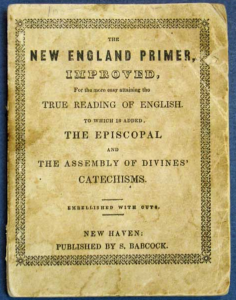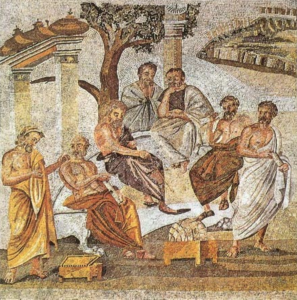By Margueritte Peterson
Ah, September. The smell of sharpened pencils and new Jansport backpacks (those are probably not still “in” though, are they? I’m getting old) combined with a boatload of traffic going 15 miles per hour on random streets throughout town say one thing: Summer is out… school is in! We thought, given that many of our followers work in the school system – curating, developing collections and managing libraries, among a myriad of other tasks – we would take a quick inside look at the development of the school system around the world and the earliest forms of “textbook” education (reading primers, ABCs… Alphabet Books, and Hornbooks)!
Though originally the Greek word for school, σχολή, translated into “leisure” or “that in which leisure is employed” (listen closely kids, and this will surely impress your teacher when she asks you why you aren’t listening), eventually became known as a group to whom lectures were given. The concept of grouping those who need to or want to learn together has been known throughout classical history. Almost all ancient civilizations taught their students in bulk – Ancient Greece, Ancient Rome, Ancient China, Ancient India… lectures were given to all. Though in these civilizations lectures and schooling were usually only given to someday-to-be military personnel and academics, by the early 1700s obligatory attendance in elementary school became commonplace in many parts of Europe.
Around this time, printing had become more widely practiced, and was becoming available to the general populace of Europe and America. Literacy kept going up, given the new obligatory attendance in schools for the common man, and pamphlets and books were more readily available and distributed. Some of the tools used for schooling in early education are of interest to many collectors today. Reading Primers, Alphabet Books (or ABC Books) and Hornbooks are some of the most popular types that we will glance at today.
In all truthfulness, Hornbooks and Primers could both be considered a type of ABC book. Hornbooks, named quite appropriately, were often the alphabet and a woodcut illustration or prayer printed to a sheet of paper affixed to a wooden paddle. A thin, transparent sheet of horn was then placed over the paper to protect it (hence the name “hornbook”). These early “books” are quite collectible (in case you happen upon one in a dark corner of an antique store), as they are rare. Primarily used between the 16th to the 19th centuries, finding one intact is rare, no doubt due to the use, and abuse, of them by their petite owners! The next iteration in educational publications was the reading primer. The earliest primer known is a Latin text, translated into English as the Salisbury Prymer. It contains the alphabet and a series of Catholic Prayers, and was printed in the late 1400s. Early primers were often religious in theme, and more than somewhat didactic in nature. The earliest primer printed in the American Colonies was The New England Primer. Though originally published in Boston in 1687, it only began to be printed in greater numbers in the later 1700s, on the cusp of the American Revolution. Before this primer, most of what was used in the colonies for education were primers brought over from England with original settlers. The first US edition of The New England Primer contained a myriad of educational lessons – not only did it house the alphabet and religious lessons, but contained pages on vowels & consonants, double letters, woodcut illustrations and acronyms, among others. According to research, around 2 million copies of this title were printed and sold in the 18th century (though there are no surviving copies of those printed before the 18th century… or if you have one, please email vjz@tavbooks.com). Why place so much emphasis into a small book for young children?

Our holding of an early 19th century edition of the New England Primer. See it here>
Such a question brings us back to the developing school system in the Western World! Surprisingly, one room school houses were the norm until the 1920s, when students were finally split up by age and academic level into separate classrooms. Throughout these centuries, only the wealthy and predominant citizens were able to have private tutors and governesses to teach them. A primer allowed a child to learn a good amount on his own, and also allowed a teacher in a room with several different levels of students to assign a certain lesson to different groups. The primer, along with Hornbooks and other ABC books were useful educational tools for both students and tutors/teachers alike, and allowed for many youth to be educated in basic reading and writing skills.
Well, what are you waiting for? Back to the grind – open those notebooks, nibble on that pencil! School is back in session!



